Timeless Tuscany
Ever since my first visit to Italy many years ago, I’ve been fascinated by the Italian lifestyle. In comparison to our frenetic lives, they take things at a slower pace, and it seems to me that theirs is a simpler and happier existence. Our occasional vacation excursions there left me longing to experience their way of life, to see if it is really as it appears. I decided, and my husband Fred agreed, that renting a place to stay during part of a vacation would give us a glimpse into everyday Italian life.
I excitedly began planning such a trip. Choosing just the right place was no easy task. Hundreds of sites on the Internet offer the opportunity to view pictures, read reviews, and make arrangements for vacation rentals. We wanted to stay in or very near a town from which we could conveniently take day trips to places we wanted to visit. It should be a small town, since we hoped to get to know some local people
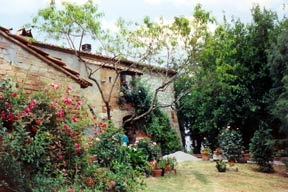
With much research, I finally found a place that was situated in the heart of Tuscany, only one kilometer from the small town of Asciano. It was in a house on a farm that grew olives and grapes. Although it was large enough to accommodate six people, the cost was reasonable even for just the two of us. We made contact with the owner, and soon we were planning our stay in a Tuscan farmhouse. Because it had extra room, we asked our nephew Paul if he would like to join us, and he enthusiastically accepted. He had never been to Italy, where his great-grandparents were born. He would arrive a few days after we did.
In mid-June, we set off on our vacation, looking forward to the week we would spend living in Asciano. Arriving in Italy, we picked up our rental car at a small agency where the clerk, who spoke no English, tried to explain the alarm system. Our comprehension of basic Italian doesn’t exactly include the vocabulary to discuss complex concepts like automobile alarms, but Fred indicated he understood, and off we drove.
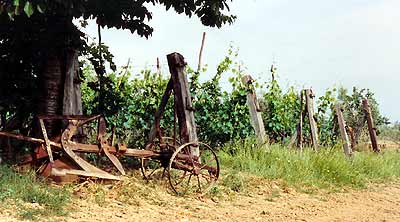
We had several hours before we were to meet the landlord at our rental, so we drove a scenic route through the Tuscan hills. We stopped for lunch in a small hilltop town. As we exited the car, the alarm went off. It was several minutes before Fred was able to stop it, and we had attracted quite a bit of attention. Very embarrassed, we decided to postpone lunch and drive on. Further along our route, we stopped at a bakery where I ran in and bought slices of focaccia while Fred kept the car running. It was apparent we needed to master this alarm!
At the appointed time, we arrived at the farmhouse which was to be our home for a week. We drove up a steep gravel road to reach it, and spotting chickens pecking in the dirt and farm equipment in the yard, I was suddenly struck by the realization that this was a real working farm, not an idyllic country villa. I hoped we had not made a mistake in choosing this place.
Our landlord, Sergio, was very pleasant as he showed us around. He spoke little English, but we were able to understand most of what he said. He lived and worked in town, which we could see not far below us, but he came to check on the farm every day. He showed us the olive orchard, a small vineyard, and a garden, telling us to help ourselves to anything we found there. Our part of the farmhouse was spacious and comfortable-looking, if a bit rustic. There was a local family living in another wing of the rambling house, but he assured us that we would have privacy. He was renovating another part of the building for his own use. It would become his “country retreat”. There was a caretaker, Maria, an elderly woman who wore the typical black dress of an Italian widow. She also lived in town, but spent her days at the farm.
We were soon left to acclimate ourselves to the living quarters, consisting of two bedrooms and a bathroom, and a large central living/dining area, dominated by a wood-burning hearth. There was a stove, but Sergio had told us we could cook over the hearth if we wished. Fred is an excellent cook, and I knew from the look on his face that he would try it before the week was out. Within a short time we were totally at home, and I began to think of it as charming rather than rustic. 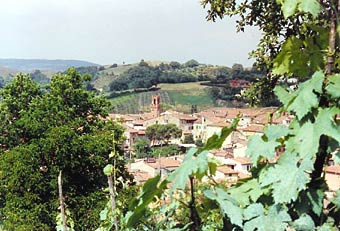
In the early evening we set out for town, hoping to find a market for supplies, as well as a restaurant, since we didn’t plan to cook many of our meals. This was a vacation, after all. We parked and once again set off the alarm as soon as we got out. While it had sounded loud the first time, it now echoed through every corner of this small town of connected stone buildings and cobbled streets. We had announced our arrival to the residents of Asciano! The good news was that we found a couple of markets where we bought provisions, and a nice restaurant where we would enjoy some wonderful meals in the coming week.
After trying out the restaurant for dinner, we stopped for an espresso at a sidewalk cafe. It seemed that all of the town’s residents were out for a late evening stroll. Sipping our coffees, we observed the social scenes surrounding us: old men playing cards at a sidewalk bar, small children in strollers being fussed over by adults, young boys kicking around a soccer ball, and nearly everyone enjoying gelato, the excellent Italian ice cream.
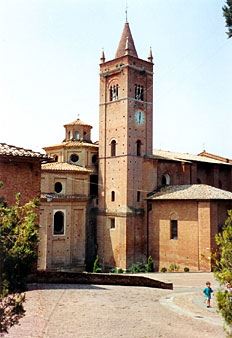 The following day was Sunday, and we spent the morning driving around the local roads which offered beautiful views in every direction. Not far from town we spotted the Abbey of Monte Oliveto Maggiore, an abbey of Benedictine monks which our guidebook told us was open to the public. We drove onto the grounds, seeing several signs proclaiming “Silenzio!” attesting to the solemnity of the place. As we parked and prepared to leave the car, we looked at each other and knew without speaking that we didn’t dare risk setting off the alarm in this quiet place. So we drove on, hoping that before the end of the week we would be able to return without this fear.
The following day was Sunday, and we spent the morning driving around the local roads which offered beautiful views in every direction. Not far from town we spotted the Abbey of Monte Oliveto Maggiore, an abbey of Benedictine monks which our guidebook told us was open to the public. We drove onto the grounds, seeing several signs proclaiming “Silenzio!” attesting to the solemnity of the place. As we parked and prepared to leave the car, we looked at each other and knew without speaking that we didn’t dare risk setting off the alarm in this quiet place. So we drove on, hoping that before the end of the week we would be able to return without this fear.
Back at our house, we prepared a late lunch and brought it outside to a table and chairs on the lawn. While we enjoyed our simple meal, from another home not far away we could hear the sounds of a large family dinner: much talking and laughing, plates and cutlery clattering, a baby’s cry. It brought back memories of the early years of our marriage, when Fred’s family had such a meal every Sunday afternoon. We couldn’t remember when or why the tradition had stopped, but it’s been many years since our extended family has gotten together for a Sunday meal.
The next morning, we drove several kilometers south to the city of Viterbo to meet Paul, who was arriving by train from Rome in the early afternoon. We did not know how long the trip would take, so we left early and took a scenic route along Lake Bolsena. Arriving before noon, we located the train station which was just outside the city walls and walked into the city to pass the time until the train arrived. We visited a few shops and stopped for a quick lunch at a sidewalk cafe. On our way back to the station, we passed a stand selling porchetta (roasted pork). We regretted that we had already eaten, but bought a sandwich for Paul, figuring he would be hungry after his long trip. The train was late, making us nervous since we had no way of communicating any changes in plans. But, it finally pulled into the station and, to our relief, Paul got off. We headed back to Asciano, with Paul enjoying his porchetta sandwich. 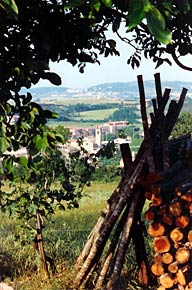
The next morning, while Paul slept off his jetlag, Fred and I went into town to pick up some food for a picnic lunch which we intended to enjoy during the day’s travels further into the surrounding countryside. We had coffee at a corner bar, then stopped at the forno (bakery) for some rolls, the alimentari (grocer) for fruit and cheese, and finally at the salumeria (deli) for some prociutto and salami. This was a far cry from our supermarkets back in the States. We were feeling quite pleased with ourselves for shopping like the locals, until our final stop, where the meats were priced by the netto, and we had no idea what that meant. We managed the situation by requesting the number of slices we wanted of each, but we realized that we certainly weren’t going to be mistaken for native Italians.
Shortly before noon, the three of us set out. We were fairly confident that the alarm system had been conquered, so our first stop was the Abbey. The cloister had outstanding frescoes depicting the life of St. Benedict. A robed monk explained the scenes until a bell tolled calling the monks to prayer before lunch, cutting our visit short. We drove on, soon coming to the walled hilltop town of Montalcino, which we had previously visited and thought Paul would enjoy. We stopped to eat our lunch at a park with nice views. Afterward, we walked around the small town, but everything was shut up tight for the long mid-day siesta, a time-honored Italian tradition, one to which we Americans certainly can’t relate. We realized that in future excursions, we needed to get an earlier start.
Returning home, we spent the rest of the day walking around the farm, trying to identify what we saw growing there. Every bit of space was efficiently utilized, with artichokes and beans neatly planted between the rows of olive trees. There was no sign of anyone tending the crops, since only the hot sun need be at work during the height of the growing season. While we walked, we speculated about Maria, the caretaker. We had become intrigued by this woman who we had seen at the farm from dawn to dusk every day. I had noticed her being brought to work on the back of a tiny three-wheeled truck that morning. At first, I was appalled that anyone would treat an elderly woman like that, but then I realized the probable alternative was having her walk since the cab of the vehicle was only big enough for the driver. We couldn’t help wondering what Maria’s situation was, but our curiosity was not going to be satisfied.
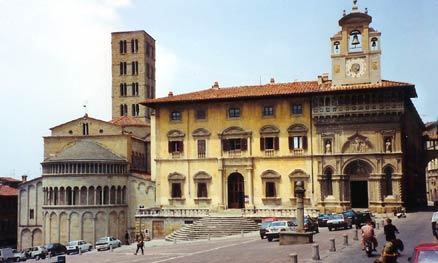
We planned to visit Arezzo the following day, and this time we managed to get started early. When we arrived in the town, it was market day, and we couldn’t resist a little bargain hunting. Arezzo is noted for its antiques, so we hoped to find something special. The market held no treasures for us, however, so we moved on to the town’s antique shops, admiring much but buying little. After shopping, we visited the medieval center of the city. There was a beautiful church, Pieve di Santa Maria, and the sloping main square, Piazza Grande, was lined with interesting buildings.
We stayed in the city until the doors began closing for the afternoon, then headed south to Lake Trasimeno. Our destination on the lake was Castiglione del Lago which was described in my guidebook as an interesting example of military architecture. Built as a nearly impregnable fortress, it sat high on a promontory overlooking the lake. To reach the castle, we walked through a long passageway, with small slots in the stone walls offering occasional glimpses of the lake and landscape below. It was easy to imagine this well-protected place being defended in feudal times. A huge park-like area with evidence of castle ruins now serves as an outdoor theatre. It made a dramatic setting.
Arriving back at our farm in the late afternoon, we were relaxing outside when we heard a loud commotion in the chicken house. We wondered what was happening until Maria appeared from around the side of the building carrying four dead chickens by their necks. Someone was going to have a big dinner this night!
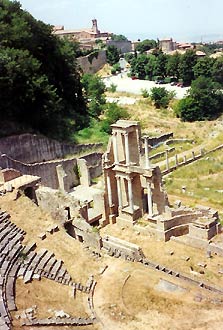
The next day our planned destination was Volterra. Along the way, a tiny walled town with numerous square towers caught our interest. Cars were not allowed inside, so we parked outside the walls and walked into the town of Monteriggionni, which was built in 1213 as a lookout fortress for the nearby city of Siena. After a brief look around and a refreshment stop at a cafe, we resumed our trip. Volterra sat high on a rocky plateau, its ramparts visible from a considerable distance. It seemed to take us forever to reach it, but eventually we arrived and parked in a large lot on the town’s outskirts. It was a short uphill walk to the central Piazza dei Priori, a medieval square surrounded by palaces. The town is famous for its large alabaster industry, and there were numerous shops offering everything from small souvenirs to large pieces of fine statuary carved from the stone. A few places allowed visitors to watch the artisans at work, their studios covered in a fine, powdery dust. After choosing a few small items to buy, we walked to the edge of town to see a fairly well preserved amphitheatre which included a Roman bath. When the shops began closing, we stopped for a leisurely meal before heading back home.
I decided to walk into town to pick up a few things once the shops reopened. The walk down into town was easy if a little dusty on the unpaved road. I stopped at the central cafe for an iced tea for which I had to specify that I wanted ice since the Italians do not use it in their drinks. I realized my Italian must be improving since I got exactly what I wanted! I sat at a table outside, watching children playing a game of street soccer, their yells and laughter echoing off of the same walls from which our car alarm had reverberated only a few days earlier, which now seemed like a lifetime ago.
That night, we went to dinner at a simple roadside trattoria we had seen outside of town. The restaurant was expectedly small and rustic. What wasn’t expected was the question we were asked as we were seated, “Carne, Pesce, o Vegetariano?” Meat, fish, or vegetarian? We had become accustomed to restaurants that didn’t have menus, but the offerings had always been much more specific than that! But, being good sports, we all answered, “Pesce”. A basket of delicious-looking assorted breads was placed at the table, along with a carafe of cold white wine. We wondered what would come next. Soon, a variety of seafood appetizers was served. As we finished the delicious assortment, a new selection was brought out. Thus began a parade of dish after dish of seafood and fish prepared in every conceivable way. The appetizers gave way to risottos and pastas. The carafe was never allowed to go empty. Just when we thought there was no way we could possibly be served any more, out came our waitress carrying a tray featuring a small upright tree with huge grilled shrimp skewered on its branches.
The meal had taken several hours and the tiny restaurant had filled up while we ate. It appeared that the meals were paced so that everyone finished at about the same time. Then out came the desserts and grappas. It was indicated that we should help ourselves and pass things along to the next table. Everyone was slightly drunk and overfed, and there were many gestures indicating that we were not able to eat any more, but most of us sampled a little nonetheless. We had absolutely no idea what this would cost, and we now waited with some apprehension for the check. It was presented to us along with a wrapped package of desserts to take home. The cost was forty Euros per person. Not bad for what was certainly our most memorable meal. When we later tried to remember all of the different dishes we had eaten, we recalled at least seventeen.
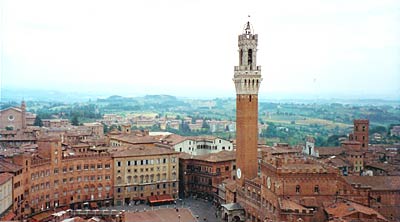
The week had flown by, and suddenly it was Friday, our last day in the farmhouse. We traveled to nearby Siena, having saved the best for last. In the heart of the city is the huge town square, Piazza del Campo. It is surrounded on three sides by busy cafes, and its center was crowded with tourists relaxing on the slanted brick pavement, soaking up the warm rays of the sun. The fourth side is dominated by a tall bell tower, Torre del Mangia, flanked by a Gothic town hall and museum. We climbed to the top of the tower, where we were rewarded by spectacular views of the city’s sprawl of red tile roofs for which we imagine the color Siena was named. We also had a good view of the monumental Duomo (Cathedral) and the surrounding hills in the distance. We then visited the beautiful white and black marble Duomo and were amazed by the inlaid marblework on its floors, as well as its impressive frescoes. The adjacent museum held even more art treasures.
When we returned home in the late afternoon, the decision was made to cook dinner in the open hearth. Paul and I foraged for wood while Fred planned the meal. The guys started the fire, and I was sent to the garden for rosemary to season the pork we planned to roast. I searched the entire garden but could not find any rosemary, which we knew to be a staple of every Italian garden. I returned empty-handed, and Fred went to look for himself. He also returned empty-handed just as Sergio pulled up to the house. Fred called out to him, “Sergio, dove il rosmarino?” Where is the rosemary? Sergio answered that it was in the garden. Fred explained that we couldn’t find it, so Sergio good-naturedly indicated we should follow him as he strode off in the garden’s direction. There, he indicated the eight foot tall hedge that surrounded the garden. It was rosemary!
Naturally, we had picked the hottest day to cook with a huge indoor fire. Sergio laughed at us as we kept moving the table further and further away from the fire, until we were nearly outside, which we would have been if we thought the huge table would fit on the tiny porch. We soon had a delicious meal of spaghetti with fresh herbs, roasted pork, and vegetables from the garden. We even had the wonderful desserts which had been sent home with us the previous night.
As we sadly said our goodbyes to Sergio and Maria, we felt that we couldn’t have chosen a better place. We each knew that the memories of our week on the Tuscan farm would last forever. We had seen the town of Asciano as it had been for the past several hundred years, and I knew it wasn’t likely to change much in the future, so that years from now if we return, it will be much the same as we left it.
